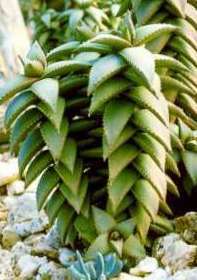Aloe pearsonii
| Aloe pearsonii | ||||||||||||
|---|---|---|---|---|---|---|---|---|---|---|---|---|

Aloe pearsonii |
||||||||||||
| Systematics | ||||||||||||
|
||||||||||||
| Scientific name | ||||||||||||
| Aloe pearsonii | ||||||||||||
| Beautiful land |
Aloe pearsonii is a species of aloes in the subfamily of the Affodilla family (Asphodeloideae). The specific epithet pearsonii honors the English botanist Henry Harold Welch Pearson (1870–1916).
description
Vegetative characteristics
Aloe pearsonii grows trunk-forming, is richly branched at the base or above and forms dense bushes with a diameter of up to 2 meters. The upright trunk is up to 200 centimeters long and 1.5 centimeters thick. The ovate-pointed to ovate-lanceolate, bent back to thrown back leaves are scattered along the trunks. The green, indistinctly lined leaf blade is 7 to 9 inches long and 3 to 4 inches wide. When dry, it turns reddish. Only on the upper side of the leaf are there numerous elongated, cloudy white spots that are more or less arranged in transverse bands. The whitish to reddish, stinging teeth on the leaf margin are 1 to 2 millimeters long and 5 millimeters apart.
Inflorescences and flowers
The inflorescence consists of two to three branches and reaches a length of about 40 centimeters. The loose, cylindrical grapes are 9 to 15 inches long and 6 to 7 inches wide. The lanceolate, pointed bracts have a length of 6 to 8 millimeters and are 3 millimeters wide. The yellow or brick-red flowers are on flower stalks about 20 millimeters long . The flowers are 23 millimeters long and narrowed at their base. Above the ovary , the flowers are widened to the mouth. Your tepals are not fused together over a length of 12 to 13 millimeters.
genetics
The number of chromosomes is .
Systematics and distribution
Aloe pearsonii is widespread on hot, dry, rocky slopes in southern Namibia and in the South African province of North Cape .
The first description by Selmar Schönland was published in 1911.
proof
literature
- Susan Carter , John J. Lavranos , Leonard E. Newton , Colin C. Walker : Aloes. The definitive guide . Kew Publishing, Royal Botanic Gardens, Kew 2011, ISBN 978-1-84246-439-7 , pp. 534 .
- Leonard Eric Newton: Aloe pearsonii . In: Urs Eggli (Hrsg.): Succulent lexicon. Monocotyledons . Eugen Ulmer, Stuttgart 2001, ISBN 3-8001-3662-7 , pp. 167 .
Individual evidence
- ↑ Urs Eggli, Leonard E. Newton: Etymological Dictionary of Succulent Plant Names . Springer, Berlin / Heidelberg 2010, ISBN 978-3-642-05597-3 , p. 180.
- ^ Record of the Albany Museum . Volume 2, 1911, p. 229.
Web links
- Aloe pearsonii in the Red List of South African Plants
